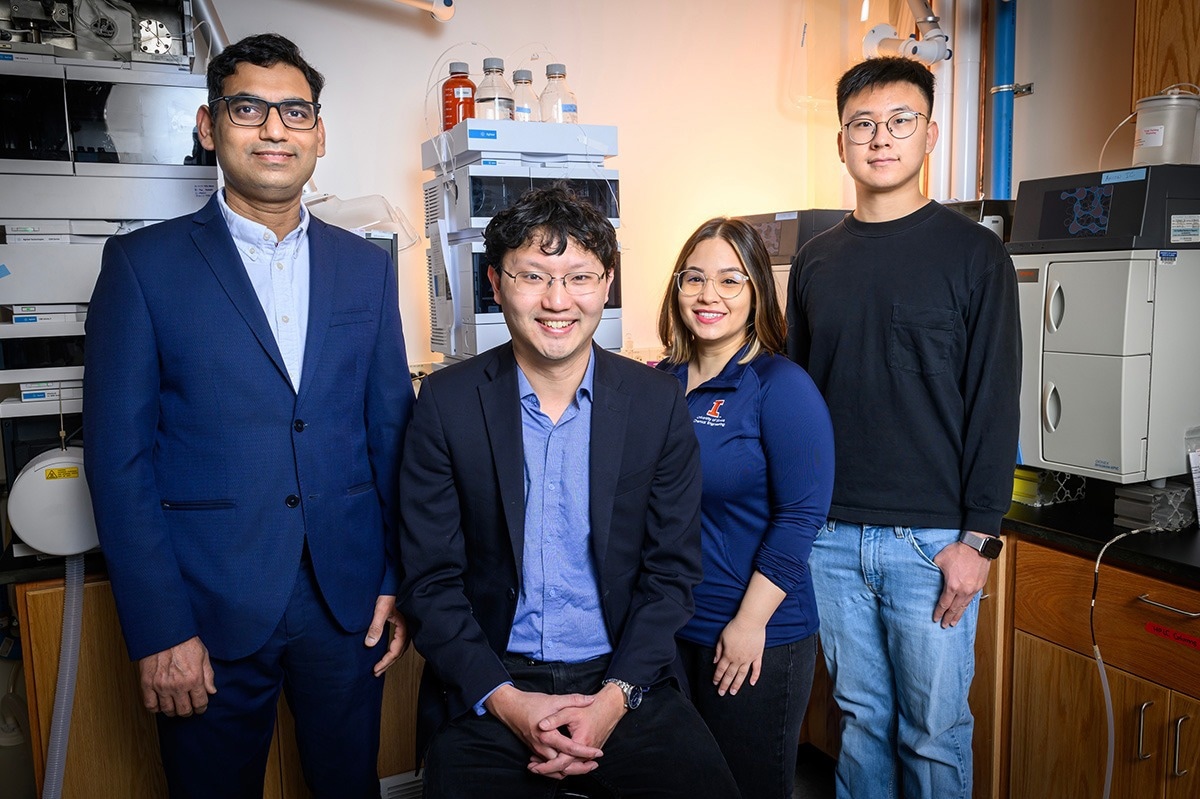Concerns have been raised about a new generation of “forever chemicals,” known as short-chain PFAS. New environmental rules are being implemented to reduce the industry-retired long-chain chemicals known as PFAS in drinking water.
 Illinois researchers including professor Diwakar Shukla, left, professor Xiao Su, Anaira Román Santiago, and Song Yin collaborated on a study that verifies that electrochemistry—rather than filtration and harmful solvents—can remove short-chain PFAS from the environment and municipal water supplies. Image Credit: Fred Zwicky
Illinois researchers including professor Diwakar Shukla, left, professor Xiao Su, Anaira Román Santiago, and Song Yin collaborated on a study that verifies that electrochemistry—rather than filtration and harmful solvents—can remove short-chain PFAS from the environment and municipal water supplies. Image Credit: Fred Zwicky
The University of Illinois at Urbana-Champaign’s research is helping to refocus attention on chemical mitigation since these chemicals, according to the research, are more mobile, persistent, and difficult to remove from the environment than their long-chain equivalents.
In a study led by professor of chemical and biomolecular engineering Xiao Su, an electrode that can attract and captivate a variety of short-chain PFAS from environmental waters is designed with the support of computer simulations, synthesis, separations testing, and electrosorption rather than filters and solvents. The results are published in the Journal of the American Chemical Society.
One of the challenges of working with short-chain PFAS is that they are not well-studied. We know that they contain fewer carbon and fluorine atoms, making them shorter molecules and, therefore, more mobile—or freer to interact within the natural environment.
Xiao Su, Professor, Chemical and Biomolecular Engineering, University of Illinois Urbana-Champaign
Su worked with Diwakar Shukla, a professor of chemical and biomolecular engineering.
He further added, “Their electrostatic properties differ and they are more hydrophilic, meaning they are more apt to bond with water molecules. These properties combined make them more difficult to separate from water than their long-chained counterparts.”
The variations between short- and long-chain PFAS, as well as long-chain PFAS in general, are important enough for Su’s team to reconsider their previously produced electrode meant to attract, collect, and remove long-chain PFAS from the environment and drinking water sources. Perfluoroalkyl and polyfluoroalkyl compounds are referred to as PFAS.
Su further stated, “One way to think of the behavior of short-chain PFAS is that they don’t like to be around anything except their own kind. “So, to attract them, we need to sort of bait them with grafted fluorine groups—the ‘F’ in PFAS—on the surface of an electrode.”
Su noted that kinship is not the sole obstacle.
“The lengths of short-chain PFAS molecules vary, giving them different physical properties. This means we need to be able to tune the electrode just right to attract and eventually release the short-chain PFAS, with molecular-level understanding of the interactions being key to success,” he added.
The study explained how different copolymer materials were carefully chosen, matched, and triangulated to create an electrode that can attract a variety of short-chain PFAS and create an electric field to help release the molecules when needed.
According to Su, this effort represented an important first step in removing the short-chain PFAS, which have supplanted long-chain PFAS in numerous industries.
Su concluded, “We still have much work to do. Future studies will focus on coupling the electrodes developed in this study with electrochemical degradation methods to ensure removal of these persistent contaminants from the environment.”
Graduate student Song Yin and Shukla oversaw the computational calculations, with Illinois researchers Anaira Román Santiago, Jiho Lee, and Johannes Elbert managing the experimental investigations.
In addition to being a professor of civil and environmental engineering at Illinois, Su is associated with the Beckman Institute for Advanced Science and Technology.
Journal Reference:
Santiago, A. R., et al. (2023) Imparting Selective Fluorophilic Interactions in Redox Copolymers for the Electrochemically Mediated Capture of Short-Chain Perfluoroalkyl Substances. Journal of the American Chemical Society. doi:10.1021/jacs.2c10963.